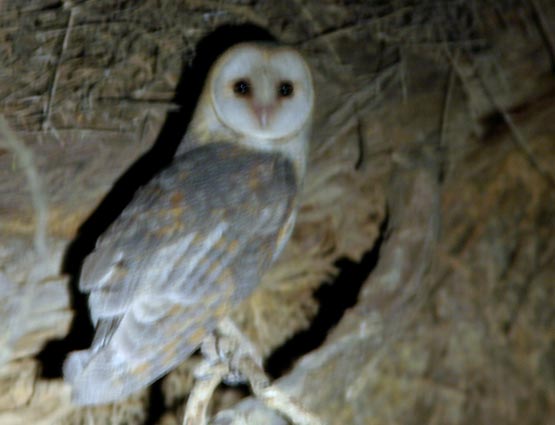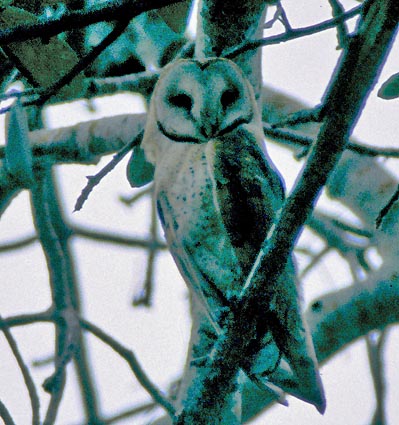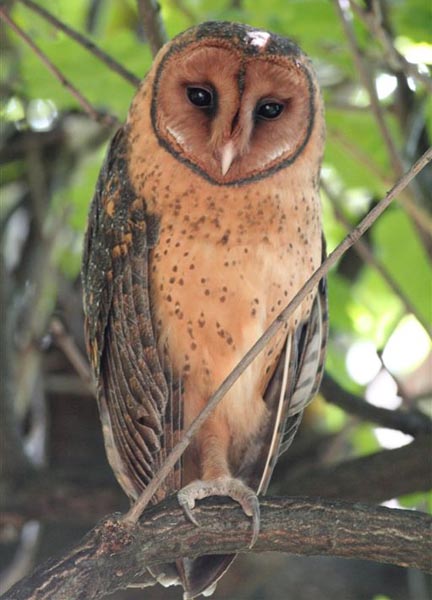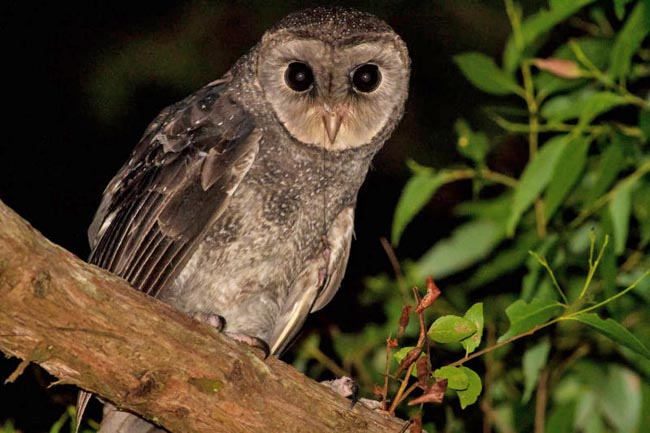
a web page by Don Roberson |
BARN-OWLS & ALLIES Tytonidae |
||
|
||
The familiar Barn Owl of North America is T.a. pratincola (left and flight shot). It is a pale buff-and-white owl which preys heavily on rodents in grasslands. Communal day roosts are sometimes formed, and there is migration by northern populations — the flight shot was taken from a boat far offshore!
The subspecies in sub-Saharan Africa is also very widespread: T.a. affinis, shown below by owls from the Kalahari Desert (taken at night, below left) and from Tanzania in east Africa (below right). |
||
|
||
While there are additional widespread races in Europe to north Africa (nominate alba), in southeast Asia through the Greater Sundas (javanica), and much of Australasia (delicatula), there are many insular island races in the southwestern Pacific, in the Caribbean, in the Galapagos, and on islands off Africa and India. Barn Owls reside in a very wide variety of habitats — usually open country that can range from deserts to grasslands to savannah — but also marshes, palm plantations, rocky coasts and, on islands, forests. Availability of prey, usually nocturnal small mammals, is a key element to their success. There are some recent proposals to split populations into various separate species. For example, Wink & Heidrich (1999) reported only 1.8% divergence in mitochondrial DNA between the North American Barn Owl T.a. pratincola and Ashy-faced Owl T. glaucopes of Hispaniola, but both were 8% divergent from Barn Owls in Europe (T.a. alba) and South Africa (T.a. affinis). They concluded the New World populations should be split at the species level from Old World population. More work needs to be done using newer genetic techniques (using nuclear DNA in addition to mitochondrial DNA) and better global sampling. For the moment a single Barn Owl species is recognized by most global lists, making it, along with Peregrine Falcon, as perhaps the most widespread landbird on earth. |
||
There are a series of island endemic masked-owls, including two on Sulawesi [Sulawesi Masked-Owl T. rosenbergii, Minahassa Masked-Owl T. inexspectata] and single species on Taliabu [T. nigrobrunnea], Tanimbar and Buru [Lesser Masked-Owl T. sororcula], Seram [T. almae], Manus [T. manusi], New Britain [Golden Masked-Owl T. aurantia], and the Andaman Is. [Andaman Masked-Owl T. deroepstorffi]. Quite a number of these are very poorly known and are listed in "Vulnerable" in lists of threatened species. Not only are the Tasmanian race of Australian Masked-Owl and the Golden Masked-Owl of New Britain washed with orange coloration, but so are a smattering of the island endemics. |
||
Schodde & Mason (1981) postulated that widespread T.t. tenebricosa of Australia should be split from both the York Peninsula bird and T.t. arfaki of New Guinea. Norman et al. (2002) examined this issue using mitochondrial and nuclear DNA. They found that the three isolates were equally diverged genetically, at a level consistent with intraspecific variation in other owls, and concluded that only one species should be recognized. Christidis & Boles (2008) followed that approach, and so does, for example, the Clements world checklist. There are two widely-separated populations of grass-owls. African Grass-Owl T. capensis forages in open grasslands and marshes in southern half of Africa. The Australasian Grass-Owl (below, shown in flight over a marsh in the Philippines) ranges from the Indian subcontinent east to s. China, New Guinea, and northern Australia. |
||
|
||
The Tytonidae contains some famed and enigmatic species. The Madagascar Red Owl Tyto soumagnei is a close relative of Barn Owl but "it constitutes a small, dark, island form [and has] always bee regarded as a separate species, and indeed sometimes a separate genus Heliodilus" (Bruce 1999). By "small and dark" he means a smallish barn-owl heavily suffused orange-red, and traditionally linked with undisturbed rainforest. My friend the late Luke Cole gave a wonderful presentation called "in search of the Red Owl," recalling his prior Madagascar trips and his (as yet) unsuccessful attempts to see one. He used it as a metaphor for life. He did see the Red Owl on his third attempt. Very sadly he died in an auto crash in Uganda shortly thereafter, and I never got to talk to him of his experience. There is an absolutely wonderful full-page photograph of Madagascar Red Owl perched in a giant rainforest tree on p. 64 of Vol. 5 of the Handbook of the Birds of the World, by Russell Thorstrom. A photograph that captures not only the essence of a prime bird like this, but spectacularly illustrates its habitat, reminds me of those elements I love in the art of Robert Bateman. The other enigmatic species are the three bay-owls, usually assigned to their own subfamily Phodilinae: Oriental Bay-Owl Phodilus badius, Sri Lanka Bay-Owl P. assimilis, and Congo Bay-Owl P. prigoginei. It is hard enough to see either of the Asian species [they have so far eluded me], but the African bird is near mythical. It was first discovered in 1951 and not rediscovered until 1996 — in the Itombwe Massif of easternmost Democratic Republic of the Congo (known as Zaire back in those times) — but these forest are among the most difficult to reach on earth. I note today that so far not one has been entered in eBird. The only known photo of Congo Bay-Owl appears in the HBW account (Bruce 1999). |
||
Photos: The four photos of Barn Owl Tyto alba
were from (upper left) San Lorenzo Creek, San Benito Co., California,
on 15 Jan 2011; (flight shot) on a boat offshore Pt. Sur on 27 Aug
2006; (night shot) in Kalahari- NP, South Africa, on 3 July 2005; and
(lower right) in Tarangire NP, Tanzania, in Aug 2002. Murray Lord
photographed the Tasmanian race of Australian Masked-Owl Tyto novaehollandiae in Hobart, Tasmania, on 22 Dec 2005. Murray Lord photographed the Sooty Owl T. tenebricosa at Washpool NP, NSW, Australia, on 30 Dec 2013. The Australasian Grass-Owl Tyto longimembris was over the Candaba marshes, Luzon, Philippines, on 30 Dec 2005. Family Book:
Family Book:
Literature cited:
|
 The
Tytonidae is a family of nocturnal owls that diverged from the
Strigidae owls about 47 million years ago (Prum et al. 2015). Aside
from three secretive bay-owls [genus Phodilus], all remaining 15 species are within the genus Tyto. These owls have varyingly pale heart-or-oval shaped faces. Barn Owl Tyto alba
(left and inset flight shot, and two more photos below) is by far the
most familiar, and occurs on all wooded continents. Over 45 subspecies
have been named (about 28 currently recognized; Bruce 1999).
The
Tytonidae is a family of nocturnal owls that diverged from the
Strigidae owls about 47 million years ago (Prum et al. 2015). Aside
from three secretive bay-owls [genus Phodilus], all remaining 15 species are within the genus Tyto. These owls have varyingly pale heart-or-oval shaped faces. Barn Owl Tyto alba
(left and inset flight shot, and two more photos below) is by far the
most familiar, and occurs on all wooded continents. Over 45 subspecies
have been named (about 28 currently recognized; Bruce 1999). 


 The
highest diversity in the Tytonidae is present in Wallacea through
Australasia where there are, beside Barn Owl, seven masked-owls, a
sooty-owl and a grass-owl. This is Australian Masked-Owl of the Tasmanian race castanopes
(right, in a great shot by Murray Lord). This golden-colored population
has been split as a species in the past ["Tasmanian Masked-Owl"] but
recent studies of variation within the entire Australian Masked-Owl
populations has supported merging it (Bruce 1999).
The
highest diversity in the Tytonidae is present in Wallacea through
Australasia where there are, beside Barn Owl, seven masked-owls, a
sooty-owl and a grass-owl. This is Australian Masked-Owl of the Tasmanian race castanopes
(right, in a great shot by Murray Lord). This golden-colored population
has been split as a species in the past ["Tasmanian Masked-Owl"] but
recent studies of variation within the entire Australian Masked-Owl
populations has supported merging it (Bruce 1999).  In New Guinea and eastern Australia the rain-forest species is Sooty Owl
(left, another nice shot by Murray Lord). It has been the subject of
taxonomic debate. Bruce (1999), for example, split it into Greater
Sooty-Owl [Australia and New Guinea] with Lesser Sooty-owl T.[t.] multipunctata an oddity on the York Peninsula of Australia, between the ranges of Greater to the north and south.
In New Guinea and eastern Australia the rain-forest species is Sooty Owl
(left, another nice shot by Murray Lord). It has been the subject of
taxonomic debate. Bruce (1999), for example, split it into Greater
Sooty-Owl [Australia and New Guinea] with Lesser Sooty-owl T.[t.] multipunctata an oddity on the York Peninsula of Australia, between the ranges of Greater to the north and south. 

